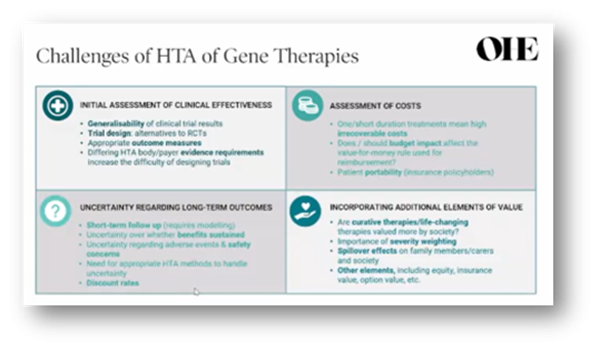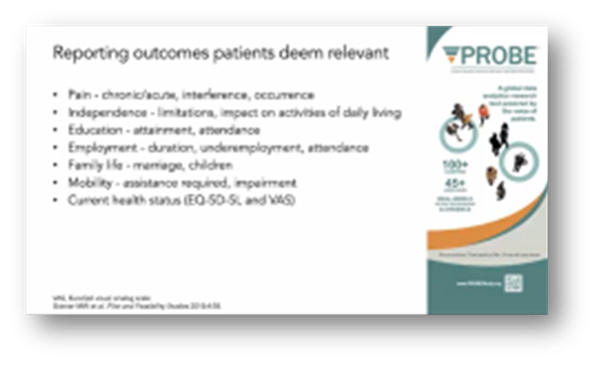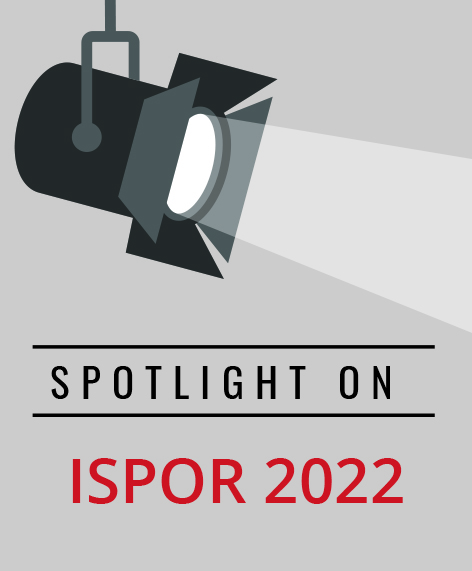HTA for Gene Therapies: Are Our Methods Fit for Purpose?
Enrique M. Saldarriaga, MS, The Comparative Health Outcomes, Policy, and Economics (CHOICE) Institute, University of Washington, Seattle, WA, USA; Mark Bounthanvong, PharmD, PhD, UCSD Skaggs School of Pharmacy & Pharmaceutical Sciences, San Diego, CA, USA
Gene therapies (GT) represent a new era of therapeutics for rare and ultra-rare conditions with potential transformational benefits for the healthcare sector and society. Several of the characteristics that made GT a unique medical alternative impose challenges for health technology assessment (HTA), such as being a ‘one-time’ upfront treatment that generates long-term effects whose assessment carries important uncertainty (Figure 1). This issue panel was led by Adrian Towse, MPhil, MA (Office of Health Economics, UK) aimed to present and reconcile the challenges of value assessment for GT and provide evidence-based recommendations from 3 perspectives: academia, he patient perspective, and industry.
Figure 1. Challenges of HTA of gene therapies.

Towse initiated the session with a summary of the literature on the challenges to conduct HTA for GT. These included initial assessment of clinical effectiveness regarding both outcomes measurement and study design, uncertainty in accurately assessing long-term outcomes, costs quantification, and incorporating other elements of value such as severity weighting and spillover effects. These elements were echoed by each of the panelists with their unique perspective.
Louis P. Garrison, PhD (University of Washington, USA) presented the health economist perspective, and stated that the presence of uncertainties throughout the accrual of benefits associated with GT makes the calculation of value at launch difficult. This derives in 2 main questions: How should these be payments financed? and How are the incentives or rewards for innovation determined and to what extent they are appropriate? Garrison’s presentation focused on the latter and stated that the tacit question here is if the current HTA framework provides adequate parameters to conduct a fair assessment of GT. His conclusion is that the use of the traditional cost-effectiveness approach based on the estimation of cost per quality-adjusted life-years (QALY) is a good starting point but the concept of value needs to be expanded to reflect the impact of the severity of the disease on the cost-effectiveness threshold and the effect that uncertainty plays in the treatment in risk-averse individuals.
"Real-world evidence is transforming the decision-making process for payers. But how do we ensure that the data generated contains information that is relevant for patients?"
Mark Skinner, JD, BS (Institute for Policy Advancement, Ltd, USA) based his presentation on the premise that real-world evidence (RWE) is transforming the decision-making process for payers. But how do we ensure that the data generated contains information that is relevant for patients? RWE is a key element in HTA for GT because while the regulatory process will be based on evidence from randomized control trials, the long-term accrual of health gains makes it necessary to collect information post-launch and focused on effectiveness. According to Skinner, outcomes measurement has historically focused on clinical status and has not necessarily taken into consideration the cycle of care experienced by the patient (Figure 2). Furthermore, while survival is still essential to define value, the goal has shifted, and from the patients’ perspective, quality of life and function status have gained relevance. Thus, it is essential to include the patient perspective in the entire process of therapeutics development to ensure the availability of data that contains outcomes that are well-aligned with the patient’s preferences. Skinner added that this could improve the shared decision process from treatment selection, which is a cornerstone of equity in healthcare.
Figure 2. Reporting outcomes patients deem relevant

Patricia Dorling, PhD, MS (Pfizer, USA) presented the industry perspective with an important remark: “As GT are innovative treatments with potential curative benefits, it is difficult to adjust currently available criteria to specific features of these novel drugs.” Therefore, one element to consider when assessing GT is that the value framework itself might need to be reconsidered because a standardized approach for GT has not been developed yet. Among the specific issues that would need to be tackled are uncertainty about clinical effectiveness, integrating social values into value-based pricing—such as the impact on severity or initial quality of life to determine an ICER threshold—incorporating additional elements of value, and policy-relevant estimates for cure, rather than disease management.
“As GT are innovative treatments with potential curative benefits, it is difficult to adjust currently available criteria to specific features of these novel drugs.” — Patricia Dorling, PhD, MS
In his final remarks, Towse mentioned that there seems to be an agreement about how much data is needed to address these issues. Because traditional RCTs will not provide these answers, it essential to collectively think how to define the data needed to be aligned with both the regulatory processes and patients’ needs, as well as the burden of its collection and quality control.

